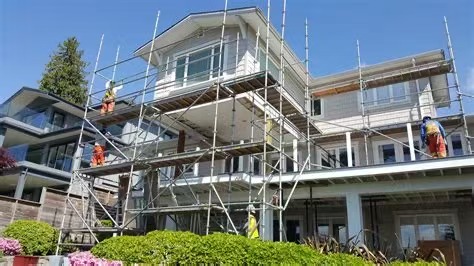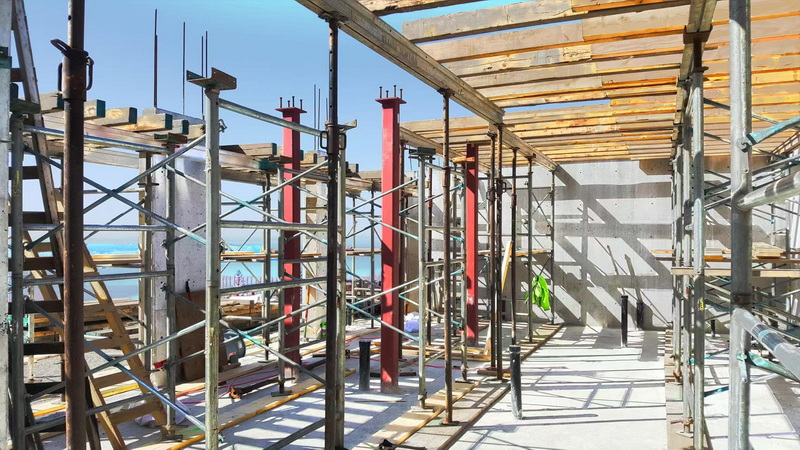Content Menu
● Overview of System Scaffolding
● Key Features of System Scaffolding
● Types of System Scaffolding
● Factors to Consider When Choosing a System Scaffold in Toronto
>> Height Requirements
>> Load Capacity
>> Working Conditions
>> Safety Considerations
● Best Practices for Using System Scaffolding in Toronto
>> Regular Inspections
>> Proper Installation
>> Training and Competency
● Case Studies
>> Case Study 1: High-Rise Building Construction in Toronto
>> Case Study 2: Residential Maintenance Project
>> Case Study 3: Event Staging
● Advanced Technologies in System Scaffolding
● Future Developments in System Scaffolding
● Sustainability and Environmental Impact
● Conclusion
● FAQ
>> 1. What are the primary types of system scaffolding used in Toronto?
>> 2. How do I ensure compliance with safety regulations in Toronto?
>> 3. What factors should I consider when choosing a system scaffold?
>> 4. Can system scaffolding be used in high-rise projects?
>> 5. How often should system scaffolding be inspected?
● Citations:
Choosing the right system scaffold for a project in Toronto involves several key considerations, including the type of project, height requirements, load capacity, and compliance with local safety regulations. System scaffolding is a versatile and efficient solution for construction and maintenance projects, offering a modular design that can be easily customized to fit specific needs. In this article, we will explore the different types of system scaffolds available, their applications, and how to select the most suitable one for your project in Toronto.

Overview of System Scaffolding
System scaffolding, also known as modular scaffolding, consists of prefabricated components that can be easily assembled and disassembled. This type of scaffolding is ideal for projects requiring flexibility and quick setup.
Key Features of System Scaffolding
- Modular Design: Allows for easy assembly and disassembly, making it suitable for projects with varying height and configuration needs.
- Versatility: Can be used in a wide range of applications, from residential construction to industrial maintenance.
- Safety: Provides a stable working platform that meets safety regulations, reducing the risk of accidents.
Types of System Scaffolding
There are several types of system scaffolding, each with its unique features and applications:
- Ringlock Scaffolding: Known for its versatility, ringlock scaffolding allows connections in eight directions, making it ideal for complex structures. It is commonly used in high-rise projects due to its stability and safety features.
- Cuplock Scaffolding: Popular for its ability to support heavy loads, cuplock scaffolding is widely used in projects requiring robust scaffolding systems.
- Kwikstage Scaffolding: Suitable for light to medium-duty jobs, kwikstage scaffolding is easy to assemble and disassemble, making it ideal for residential and commercial projects.
Factors to Consider When Choosing a System Scaffold in Toronto
When selecting a system scaffold for a project in Toronto, consider the following factors:
Height Requirements
1. Low-Rise Projects: For projects below 20 feet, a basic frame scaffold or mobile scaffold may suffice. However, system scaffolding can still be beneficial for its ease of assembly and flexibility.
2. Medium-Height Projects: For projects between 20–50 feet, system scaffolding like ringlock or cuplock is suitable due to its stability and versatility.
3. High-Rise Projects: For projects above 50 feet, specialized scaffolding systems such as mast climbing or suspended scaffolds may be necessary, but system scaffolding can still be used in conjunction with these systems.
Load Capacity
1. Light-Duty Scaffolding: Ideal for tasks like painting or plastering, where only minimal materials and workers are involved.
2. Medium-Duty Scaffolding: Suitable for jobs involving heavier tools or moderate amounts of building materials, such as bricklaying or masonry.
3. Heavy-Duty Scaffolding: Required for large-scale construction projects that need to support significant weight, including heavy materials, multiple workers, and large equipment.
Working Conditions
1. Outdoor vs. Indoor: Outdoor scaffolding must be weather-resistant and able to withstand wind, rain, and snow. Galvanized steel is often used for its corrosion resistance.
2. Unstable or Sloping Ground: Adjustable base plates or stairway scaffolding can provide stability on uneven surfaces.
3. Confined Spaces: Modular scaffolding is ideal for tight spaces due to its flexibility and compact design.
Safety Considerations
1. Regulatory Compliance: Ensure that the scaffolding meets local safety regulations, such as those outlined in Ontario's Occupational Health and Safety Act.
2. Inspections and Training: Regular inspections and proper training are crucial to ensure safety and compliance.

Best Practices for Using System Scaffolding in Toronto
To ensure the effective use of system scaffolding in Toronto, consider implementing these best practices:
Regular Inspections
Conduct regular inspections of scaffolding structures to identify any signs of wear or damage, ensuring that all components remain in good condition.
Proper Installation
Ensure that scaffolding is installed correctly according to manufacturer guidelines to maintain stability and safety.
Training and Competency
Train all personnel involved in scaffolding assembly and disassembly to ensure they understand how to properly use and inspect system scaffolding.
Case Studies
To illustrate the effectiveness of system scaffolding in real-world applications, let's examine a few case studies:
Case Study 1: High-Rise Building Construction in Toronto
In a recent high-rise building project in Toronto, contractors faced challenges with ensuring scaffolding stability and safety. By utilizing ringlock scaffolding, they were able to create a robust framework that supported heavy loads efficiently. The system's versatility allowed for easy adaptation to the complex geometry of the building structure, enhancing worker safety and productivity.
Case Study 2: Residential Maintenance Project
During routine maintenance work on a residential building, engineers needed a system to ensure safe access to elevated areas. The use of kwikstage scaffolding allowed for quick assembly and disassembly, reducing downtime and enhancing project efficiency. The lightweight nature of kwikstage made it ideal for residential projects where minimal disruption was desired.
Case Study 3: Event Staging
In a recent event staging project, contractors needed to create a temporary structure for a concert. By using system scaffolding, they were able to assemble the scaffolding quickly and efficiently, ensuring that the structure was stable and safe for the audience. The ease of installation and removal of system scaffolding allowed for rapid setup and teardown, meeting the tight deadlines typical of event staging projects.
Advanced Technologies in System Scaffolding
Modern system scaffolding often incorporates advanced technologies to enhance durability and efficiency:
- Galvanization: Provides superior corrosion resistance, extending the lifespan of scaffolding components and reducing maintenance needs.
- Customization: Many manufacturers offer customization services, allowing scaffolding to be tailored to specific project requirements, enhancing performance and safety.
Future Developments in System Scaffolding
As technology continues to evolve, we can expect further innovations in system scaffolding:
- Material Innovations: New materials with enhanced strength-to-weight ratios could lead to lighter yet stronger scaffolding components, improving efficiency.
- Smart Technologies: Integration of smart sensors into scaffolding systems could provide real-time monitoring of scaffolding conditions, enhancing safety and reducing maintenance needs.
Sustainability and Environmental Impact
System scaffolding can also contribute to sustainable construction practices by reducing waste and promoting reuse:
- Reusable Components: Modular scaffolding components can be reused across multiple projects, reducing the need for new materials and minimizing waste.
- Energy Efficiency: By optimizing scaffolding design and setup, energy consumption can be reduced during construction processes.
Conclusion
Choosing the right system scaffold for a project in Toronto requires careful consideration of project requirements, safety regulations, and environmental conditions. By understanding the different types of system scaffolding and implementing best practices, contractors can enhance efficiency, safety, and productivity on construction sites.
As construction demands continue to evolve, systems like these will remain integral in providing reliable access solutions while maintaining high safety standards.

FAQ
1. What are the primary types of system scaffolding used in Toronto?
The primary types include ringlock, cuplock, and kwikstage scaffolding, each suitable for different project needs.
2. How do I ensure compliance with safety regulations in Toronto?
Ensure that scaffolding meets local safety standards, such as those outlined in Ontario's Occupational Health and Safety Act, and conduct regular inspections and training.
3. What factors should I consider when choosing a system scaffold?
Consider project height, load capacity, working conditions, and safety requirements to select the most suitable scaffolding system.
4. Can system scaffolding be used in high-rise projects?
Yes, system scaffolding can be used in high-rise projects, especially when combined with other specialized scaffolding systems like mast climbing or suspended scaffolds.
5. How often should system scaffolding be inspected?
Regular inspections are crucial to identify any signs of wear or damage, ensuring that all components remain in good condition and can support required loads safely.
Citations:
[1] https://www.wm-scaffold.com/scaffolding-system/
[2] https://scaffoldingrentalandsales.com/blog/choosing-the-right-scaffolding-for-your-project-a-comprehensive-guide/
[3] https://riversonscaffold.com/navigating-scaffold-regulations-in-ontario-ensuring-safety-and-compliance/
[4] https://aaitscaffold.com/blog/types-of-modular-scaffolding/
[5] https://www.svelt.it/en/blog/professional-scaffolding/technical-guide-to-choosing-the-right-scaffold-68291
[6] https://ehs.utoronto.ca/wp-content/uploads/2015/10/Scaffolds.pdf
[7] https://www.avontus.com/blog/major-types-of-scaffolding-in-construction/
[8] https://scaffoldtype.com/scaffolding-size/
[9] http://www.ontario.ca/page/guidelines-multi-point-suspended-scaffolds






















